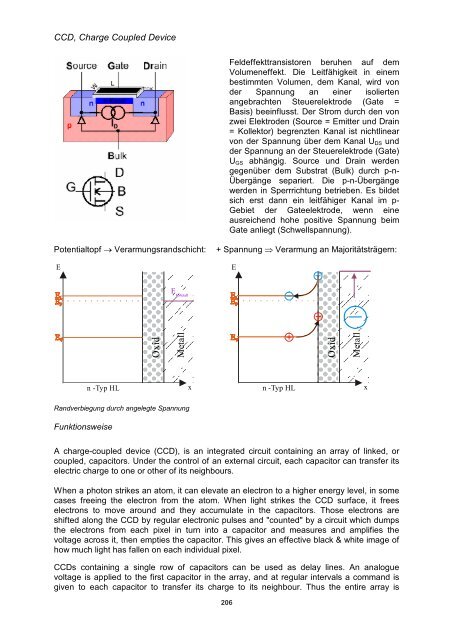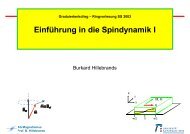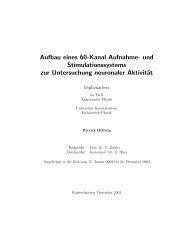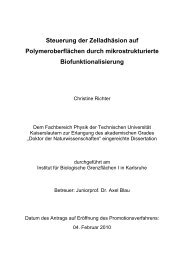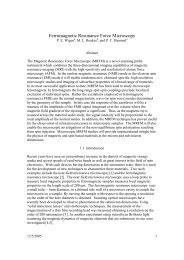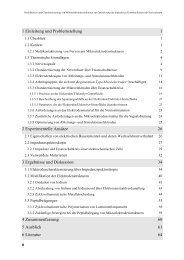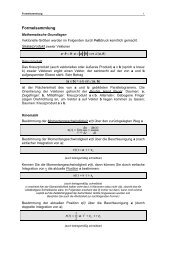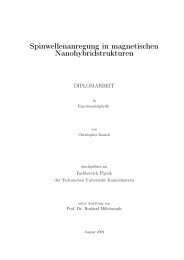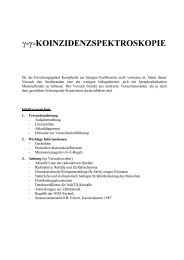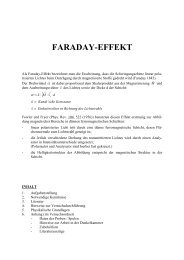Sensors and Actuators - Fachbereich Physik der Universität ...
Sensors and Actuators - Fachbereich Physik der Universität ...
Sensors and Actuators - Fachbereich Physik der Universität ...
Erfolgreiche ePaper selbst erstellen
Machen Sie aus Ihren PDF Publikationen ein blätterbares Flipbook mit unserer einzigartigen Google optimierten e-Paper Software.
CCD, Charge Coupled Device<br />
206<br />
Feldeffekttransistoren beruhen auf dem<br />
Volumeneffekt. Die Leitfähigkeit in einem<br />
bestimmten Volumen, dem Kanal, wird von<br />
<strong>der</strong> Spannung an einer isolierten<br />
angebrachten Steuerelektrode (Gate =<br />
Basis) beeinflusst. Der Strom durch den von<br />
zwei Elektroden (Source = Emitter und Drain<br />
= Kollektor) begrenzten Kanal ist nichtlinear<br />
von <strong>der</strong> Spannung über dem Kanal UDS und<br />
<strong>der</strong> Spannung an <strong>der</strong> Steuerelektrode (Gate)<br />
UGS abhängig. Source und Drain werden<br />
gegenüber dem Substrat (Bulk) durch p-n-<br />
Übergänge separiert. Die p-n-Übergänge<br />
werden in Sperrrichtung betrieben. Es bildet<br />
sich erst dann ein leitfähiger Kanal im p-<br />
Gebiet <strong>der</strong> Gateelektrode, wenn eine<br />
ausreichend hohe positive Spannung beim<br />
Gate anliegt (Schwellspannung).<br />
Potentialtopf → Verarmungsr<strong>and</strong>schicht: + Spannung ⇒ Verarmung an Majoritätsträgern:<br />
E<br />
n -Typ HL<br />
Oxid<br />
E FMetall<br />
Metall<br />
R<strong>and</strong>verbiegung durch angelegte Spannung<br />
Funktionsweise<br />
x<br />
E<br />
n -Typ HL<br />
A charge-coupled device (CCD), is an integrated circuit containing an array of linked, or<br />
coupled, capacitors. Un<strong>der</strong> the control of an external circuit, each capacitor can transfer its<br />
electric charge to one or other of its neighbours.<br />
When a photon strikes an atom, it can elevate an electron to a higher energy level, in some<br />
cases freeing the electron from the atom. When light strikes the CCD surface, it frees<br />
electrons to move around <strong>and</strong> they accumulate in the capacitors. Those electrons are<br />
shifted along the CCD by regular electronic pulses <strong>and</strong> "counted" by a circuit which dumps<br />
the electrons from each pixel in turn into a capacitor <strong>and</strong> measures <strong>and</strong> amplifies the<br />
voltage across it, then empties the capacitor. This gives an effective black & white image of<br />
how much light has fallen on each individual pixel.<br />
CCDs containing a single row of capacitors can be used as delay lines. An analogue<br />
voltage is applied to the first capacitor in the array, <strong>and</strong> at regular intervals a comm<strong>and</strong> is<br />
given to each capacitor to transfer its charge to its neighbour. Thus the entire array is<br />
Oxid<br />
Metall<br />
x


